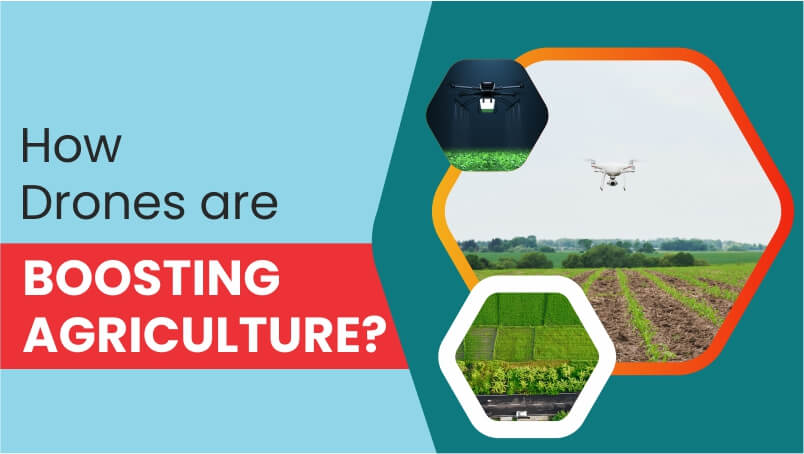Large areas of land were ploughed by tractors and mechanical harvesters in place of bullock-based subsistence farming, and GMOs were used to increase crop immunity. And right now, the next stage in the evolution of agriculture is a massive single crop unit that would produce an incredible amount of food thanks to the widespread usage of drones.
Food security will be a serious problem because of the quickly expanding population, environmental damage, global warming, and the shrinking amount of arable land, and feeding the crowding population will require innovative agricultural practices and substantial use of drone technology.
Drones Used for Precision Agriculture:
By utilizing GPS, GNSS, and drone technology, precision agriculture increases farm productivity and aids the farmer in selecting the crop that is best suited to the soil type and geological circumstances. The usage of technology also forewarns farmers to take preventative action in case of unforeseen natural calamities.
Precision agriculture depends heavily on drones, and their use will only grow as they produce the highest-quality results.
Drones with accurate sensors and high-resolution cameras may fly over farms covering thousands of hectares and collect data that can be used to map insect damage, crop stress, and per-hectare production. Without having to personally survey the field or hire workers to do so, the farmer might monitor what is happening there with the help of drone photography.
Uses of Drone In Agriculture:
Drones would provide several advantages to farmers and other agricultural industry participants. Farmers will be able to expand their knowledge of the growth patterns of various crops while also saving time and money. Productivity growth and environmental conservation would go hand in hand.
- Additionally, drones would be utilized to spray insecticides and water on crops. This would reduce wastage and save time. Drone spraying would be extremely targeted, and the drone would recognize the situation and adjust its course accordingly.
- In a similar manner, pesticides can be sprayed on crops using drones. Using drones to spray herbicides directly on the undesired weeds on the farm would be a very effective way since currently herbicides are sprayed across the entire width and length of the field.
- The precise amount of fertilizer that would be required in the fields can also be calculated by other specialized drone kinds.
Drones can revolutionize the agricultural industry and increase farm income:
Due to their wide range of applications and last mile connectivity, drones are having a significant impact on life in general. They are entering every area. Governments are attempting to deploy unmanned vehicles for public welfare after commercial drone operations by delivery giants like Amazon and Walmart began. The Indian government has developed a set of robust and practical regulations to address the expanding range of business opportunities provided by drone technology. A hundred Kisan drones, which may be used to sparingly and quickly spray pesticides and fertilizers, were recently launched by the Indian Prime Minister. Drones in agriculture can be used for marketing, surveillance, and farm operations.
They have the ability to replace ordinary manual farm tasks, optimize crop inputs, lower costs, boost output, and reduce wastages.
In recent years, India’s agricultural sector has advanced quickly. The federal government is working to overcome supply chain gaps in agriculture. Advanced irrigation methods, agricultural operation mechanization like harvesting, and robust logistics and post-harvesting technology are also receiving support. Crop protection products perform better when they are used with precision farming. Spraying pesticides is difficult due to product waste when utilizing tractors or manual labor. However, drones use fertilizers, insecticides, and nutrients wisely since they can spray pesticides equally and quickly in predetermined places.
Through the cameras put on them, drones can assist farmers in observing crop growth. Farmers may even check the progress of the entire crop and look for any pests and diseases without having to walk across the fields. It reduces the dangers to human health and the environment brought on by pesticide spraying. Kisan drones would be able to transport 5–10 kg of crop inputs, which may be evenly sprayed across an acre of land in about 15 minutes. These drones can even be used by farmers to deliver fresh produce and seafood to nearby markets. As a result, transportation will be quicker, more affordable, and less damaged.
Benefits of Drone Technology:
Drone surveys are becoming more popular and more affordable. They are quite advantageous in agriculture. Here are a few of them:
Enhanced Production – The farmer can boost his or her capacity for production through thorough irrigation planning, sufficient crop health monitoring, increased understanding of soil health, and environmental adaptation.
Effective and Adaptive Techniques – The use of drones gives farmers regular updates on their crops and aids in the development of more effective agricultural practices. They can allocate resources efficiently and adjust to changing weather conditions.
Greater farmer safety – Using drones to spray pesticides in difficult-to-reach terrain, contaminated areas, taller crops, and power lines are safer and more practical for farmers. Additionally, it aids farmers in avoiding crop spraying, which reduces soil contamination and chemical toxicity.
Useful for insurance claims: Farmers utilize the information obtained by drones to submit insurance claims for crop damage. Even if they are insured, they nevertheless analyze the risks and losses related to the land.
How to buy drones on subsidies?:
Many farmers in India are still living in poverty, therefore they might not have the money to purchase drones. A further issue is the limited land holdings. Custom recruiting centers sponsored by farmer’s producer organisations (FPO), farm cooperatives, and even agri start-ups can be quite helpful in spreading the advantages of drones to small and marginal farmers in such a situation. The ministry of agriculture grants FPOs a 75 percent grant and provides grants totaling Rs. 10 lakhs to agricultural institutes for the procurement of drones. Farmers may have simple access to drone technology thanks to government funding. Drone labor will be significantly less expensive than human labor.
One significant tool that has the potential to revolutionize the agricultural industry is the drone. A few years ago, the private sector began to make use of drones’ business advantages. It is encouraging to see that the government is now attempting to utilize it extensively for the welfare of farmers. The Indian government has made the decision to have a local start-up produce 100,000 drones over the next two years.
For tractor, tractor price, farm machinery related information install KhetiGaadi application. KhetiGaadi provides you with the tractor, farming methods, etc related detailed information.




